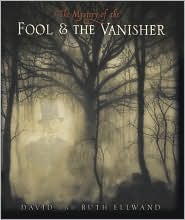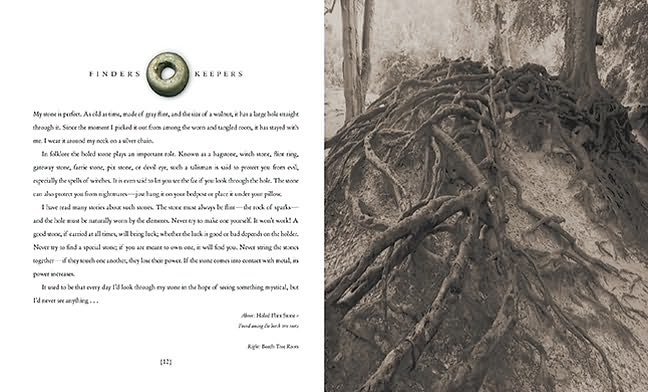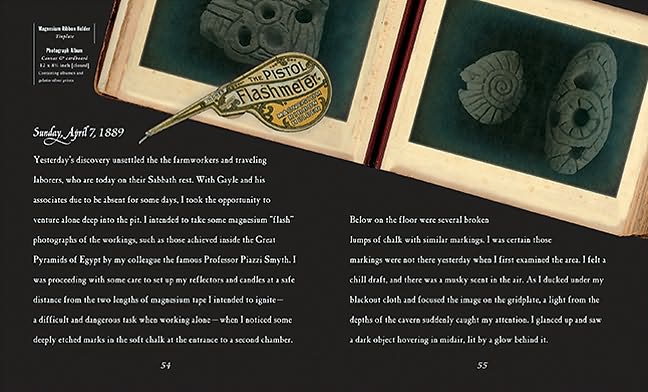 What The Mystery of the Fool & the Vanisher seems to be: a straight-up account of a modern writer and photographer, David Ellwand, finding evidence of the existence of actual pixies or faeries. Inside an old, locked wooden box he finds hidden near the ruins of a decrepit house, Ellwand discovers the story of Isaac Wilde, a nineteenth-century photographer who has left a journal, some photographs, some artifacts, and a wax recording. Wilde accompanied an archaeological dig during Victorian times, and they delved inside a barrow that should not have been disturbed.
What The Mystery of the Fool & the Vanisher seems to be: a straight-up account of a modern writer and photographer, David Ellwand, finding evidence of the existence of actual pixies or faeries. Inside an old, locked wooden box he finds hidden near the ruins of a decrepit house, Ellwand discovers the story of Isaac Wilde, a nineteenth-century photographer who has left a journal, some photographs, some artifacts, and a wax recording. Wilde accompanied an archaeological dig during Victorian times, and they delved inside a barrow that should not have been disturbed.What The Mystery of the Fool & the Vanisher is: A graphic novel of a different kind, in which the visuals are all (or mostly) photographs or photographs of objects. The photographs are produced through a variety of media, including daguerrotypes and more. The details of what philosophical societies during the time of Queen Victoria were like are spot on, as are the descriptions of the Victorian fondness for "science" and archaeology. This one will leave you wondering what was real, and what was fiction, and where, exactly, that line blurred.
When I say that "you simply must see and read" this book, I don't mean that you'd only believe it if you read it. I mean GO READ THE BOOK.
But really, first I ought to tell you why, and before telling you why, I should probably tell you a bit of the what. Also, I have to divulge my particular bias, which is in favor of the notion of fairies/pixies living in the barrows on the English Downs (a la Tolkien and Pratchett).
The what
This graphic novel contains photographs by David Ellwand (some of people, some of objects, some of sketches). These aren't just any photographs. Some of them are from highly modern equipment, but a number of them are from very old processes involving glass. Some are even daguerrotypes, positive images made using silver and mercury. The front matter, located in the back of the book, bears this notation about the photos: "The photographs were created with magic and necromancy." Having seen the book, I believe it.
On the inner title page, the book bears this subtitle/legend: "Being an investigation into the life and disappearance of Isaac Wilde, artist and fairy seeker". The written text is split into three parts: the first is from "David Ellwand's personal journal with additional notes from his photographic notebook"; Part Two bears this subtitle -- "Being a complete transcript of the phonograph recordings of Isaac Wilde documented here alongside photographs of the contents of the wooden box"; and Part Three is the remainder of David Ellwand's personal journal.

Image of two-page spread from part I of the book
David Ellwand spins a story about a mysterious happening on the Downs of England, a land of flint and chalk and barrows, referenced by J.R.R. Tolkien in The Fellowship of the Ring as the Barrow Downs, and spoken of with humor and affection by Terry Pratchett in The Wee Free Men and its two sequels. While walking one day, Ellwand found a "devil's eye", a round piece of flint with a hole worn in the center, through which (as anyone who has read The Spiderwick Chronicles or seen the movie can attest) one can see fairies. Come to think of it, Gaiman borrowed that device in Coraline, but I digress. Returning to the area, Ellwand eventually found himself drawn to an old house, eventually finding a heavy wooden box, once the property of Isaac Wilde.
Ellwand documents the contents of the box, which include old wax phonograph recordings. With help, the phonograph recordings were salvaged and recorded to CD, then transcribed for inclusion in the book. Because of the use of photographic evidence and journalistic reporting techniques in the first part of the book, it is easy to allow oneself to believe that the contents of the book are true, which makes it particularly intriguing, in my opinion. The middle part of the book is a transcript of the recordings, accompanied by materials which are alleged to have been the finds and creations of the fictional Isaac Wilde, a photographer hired by a fictional Victorian-era archaeologist named Gibson Gayle to document an archaeological dig on the Downs. Wilde includes stories learned from some of the locals, who believe that pixies inhabit the mounds on the Downs (as the Nac Mac Feegle do in the Pratchett books). The pixies photographed by Wilde, however, dress more like Victorian gentlemen and less like the Celtic warriors in Pratchett's books.
It turns out the Gayle is a ne'er-do-well who belittles Wilde, and Wilde is a good guy who, through the use of his own devil's eyes, has seen the fairies inside the dig, and tries to get Gayle to leave the place (and the fae) alone. Rumor has it it's a bad idea to piss off the fairies. You'll have to read the book to see what can happen if one does.

Two-page spread from Part Two, with text and photographs by "Wilde"
The Why
The photographs in this book are genius, pure and simple. Not just the photos, but their carefully crafted subject matter as well. Want to see a photograph of a 7-inch suit of armor made of mussel and oyster shells? A splinter-sized sword made of fossils? A helmet made of a snail shell and some bird feet? How about a wooden mask with real teeth and devil's eyes? And I can't tell you what the final photograph in the body of the book is, but underneath the flap is something magical. You know you want to see it.
Plus, the history/mystery that is the core of the book is built up cleverly, with credibility carefully crafted from the nested narrative and the photographs. This one sucks you in, and doesn't let go. (It also doesn't take particularly long to read, if I'm being truthful, but that's neither here nor there.)

I have this one in my column next month Kelly. I thought it was pretty cool and the photography is stunning. It almost seemed like a more grown-up version of "Spiderwick" - which I also liked a lot.
ReplyDeleteOkay, I'm sold. Gotta find this book now.
ReplyDeleteAlthough, to be perfectly honest, the tiny suit of armor sounds like something out of the Look Alikes books series.
Colleen: I reviewed it at Writing & Ruminating in August. It really kept me thinking about it after I put it down, for the extreme blurriness between reality and fiction.
ReplyDeleteA Paperback Writer: I've not seen the Look Alikes books, so what you say may be true. But Ellwand's been making and photographing small faerie clothes for a few years now. He did the Faerie-ality books, which include lots of clothes and whatnot made of flower petals, etc.
Don't tend to be into graphic novels, but this sounds intriguing. Definitely think my boys would like it, plus my husband who tends to not pay any attention to what the kids and I read.
ReplyDelete